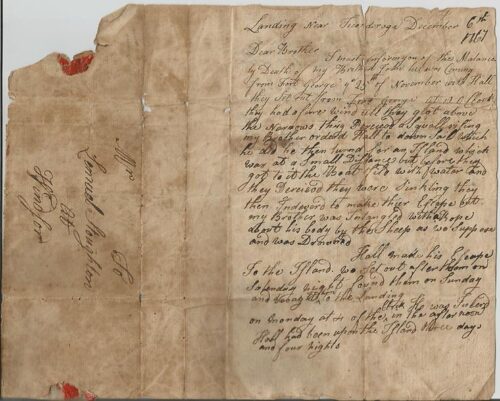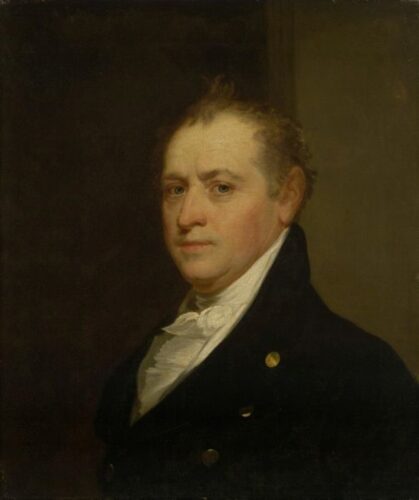Elizabeth Stoughton, born 27 November 1766, was the daughter of John and Ruth Belden Stoughton. Her father, John, was a Lieutenant in one of King George III’s colonial “Independent Companies of Foot” during the French and Indian War. Shortly after the beginning of this war the British king, to increase the numbers of his troops, promised land grants to crown lands to those who served out their enlistments, based on rank. At the conclusion of the French and Indian War (Treaty of Paris, 1763) John Stoughton made application as an officer of that war, and was awarded on 7 August 1764, about 2,000 acres in Ticonderoga.
Of the many discharged officers and enlisted soldiers awarded grants at this place, John Stoughton actually took possession and began developing his grant as required by the award; and, by doing so is recognized as being Ticonderoga’s first settler. To get a sense of the location and size of his grant we use today’s landmarks to roughly defined its boundaries. Beginning at the downtown section on the south side of LaChute River then making a line from there to the top of Mount Defiance, to the Black Point beach area, then across Lake George in a southwesterly direction to Rogers Rock – from there returning in a northerly direction along the route of Baldwin Road and continuing following that line along the westerly bank of the lake’s outlet, LaChute River, to where it changes direction in a northeasterly line back to the downtown area.

Along with other Stoughton family members in the spring of 1767, John Stoughton came to Ticonderoga to settle his grant. He, his wife Ruth with “young Lady,” began homesteading there by settling their residence at the old block house at the Lake George landing near the rapids, a relic of the military history of this place. (This blockhouse image is representative of the one that was located at this site.)

Samuel Deall, a New York City merchant and land speculator had established a business partnership with John. On one of John’s trips south to pick up animals and trade goods sent up by Mr. Deall in late November 1767 turned to become a fatal journey.
Landing near Ticonderoga Dec. 6, 1767
“Dear Brother — I must inform you of the melancholy death of my Brother John. He was crossing from Fort George the 25th of November with Hall. They set out from Fort George at 12 o’clock and encountered a fierce wind until they got above the narrows when they perceived a squall arising. My brother ordered Hall to down sail which he did and then turned for an island which was at a short distance but before they could reach it the boat filled with water and they perceiving that they were sinking. They endeavored to make their escape but my Brother was entangled with a rope about his body with the sheep, as we suppose and was drowned. Hall made his escape to the island. We set out after them Saturday night and found them on Sunday and brought them to the Landing. He was interred on Monday at 4 o’clock in the afternoon. Hall had been upon the island three days and four nights. One horse, six cows and five sheep were saved. He had three wagon loads of goods on board which he had brought from Albany which are most of them lost as far as we can find out. He had likewise 15 bushels of corn and 30 bushels of turnips which were all lost.
Joseph with his family has returned to the block house. I should be glad if you would pay us a visit if possible. My sister desires the favor of one of your sisters to come up and tarry with her this winter, for further particulars inquire of Hall. My duty to parents – love to brothers and sisters and proper regards to friends.
So I remain your loving brother – Nathaniel Stoughton”


Mother and daughter moved back to Connecticut. The Stoughton lands at Ticonderoga were sold to Samuel Deall. On 1 June 1785 Elizabeth married Oliver Wolcott, Jr, the son of Oliver Wolcott, a Governor of Connecticut, and a signer of the Articles of Confederation and the Declaration of Independence.

Oliver, Jr. was a 1778 graduate of Yale and enlisted in 1779 into the Continental Army’s Quartermaster’s Department. After the American Revolution he entered politics and advanced through various state positions to become Connecticut’s Comptroller in 1788. The following year he moved on to national service and became the Auditor of the National Treasury and in 1791 became Comptroller of the United States Treasury. In 1795 he was appointed the second Secretary of the Treasury (following Alexander Hamilton.) He retired from federal service and moved to New York City in 1803 and began a private sector career – helping found the Bank of American – and holding corporate positions in trading businesses and real estate.

by Gilbert Stuart circa 1783
After twenty years of marriage, Elizabeth died in 1805 from consumption. During those years she was well known as a fine hostess here and abroad. Oliver, Jr. and Elizabeth had five sons (three died early) and two daughters: Oliver Stoughton Wolcott, John Stoughton Wolcott, Elizabeth Wolcott Gracie and Laura Wolcott Gibbs. She is buried in the East Cemetery Wolcott Family Lot at Litchfield, CT. Father John (1735-1767) is buried at Ticonderoga and Mother, Ruth Belden Wyllys (1747-1807) is buried at Hartford, CT and Elizabeth at Litchfield, CT.
1/6/19 wgd
#ElizbethStoughtonWolcott #JohnStoughton #SamuelDeall #TiconderogaLandGrants